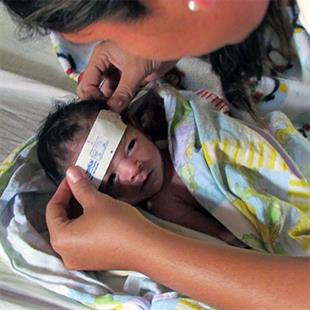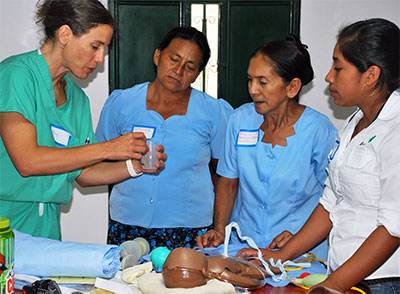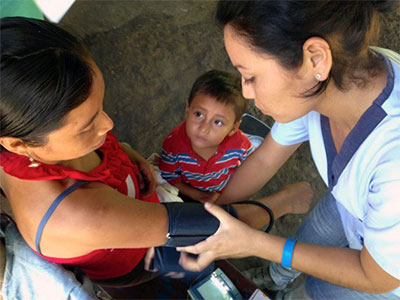CU Faculty Train Guatemalan Nurses to Improve Care
Project aims to boost health of mothers and newborns

By Tonia Twichell
(May 2018) After the birth center at Trifinio Center for Human Development opened in rural Guatemala in December 2016, Gretchen Heinrichs, MD
Situated in southwest Guatemala along the border with Mexico, the clinic provides health services in one of the country’s most impoverished regions, where the neonatal mortality rate is among the highest in Central America at 31 per 1,000 live births, and the maternal death rates is one of the highest at 80 per 100,000 live births.
Half of the women in the area lack prenatal care and one-third give birth at home assisted by traditional birth attendants, who have little formal training.
Most local women are in good health, said Heinrichs, CU associate professor of Obstetrics and Gynecology and director of maternal health programs at the Colorado School of Public Health Center for Global Health, so “we realized that the best way to make a difference was to create a safety net around a birth at home.”
CU physicians, nurses
The effort to improve the health of Guatemalan women and their babies faces significant obstacles:
- Families lack funds to pay for hospital births. “A lot of women delivering at home would love to deliver in a clinic, but they can’t afford it,” Heinrichs said. She recalled a couple so poor the husband chose to deliver the couple’s child alone. Nurses from the center rushed to the family’s home when neighbors reported the baby had breathing problems. “The nurses’ relationship with the community provided a kind of safety net that day,” she said.
- Few physicians practice in remote areas. Before the clinic opened, the closest doctor was at least an hour away. Those who were nearest were often not trained in obstetrics so complications often went unnoticed or unaddressed. Most developing countries rely on trained midwives, but Guatemala only began its midwife training program in 2015.
- Traditions can stand in the way of basic services. Many women refuse to leave home once labor begins based on a local belief that fresh air can be dangerous to women for several weeks around childbirth. Plus “this idea that birth needs to be monitored by someone who doesn’t know you is a hard concept to accept,” Heinrichs said.
 To better understand the health of the community, CU physicians and public health practitioners have been working with residents to learn about social, economic, health, cultural, geographic and genetic factors. Heinrichs and her colleagues at the Center for Global Health joined with the community to create Creciendo Sanos: Madres Sanas y Ninos Sanos, a registry for pregnant women and their young children living in the community with a population of about 25,000.
To better understand the health of the community, CU physicians and public health practitioners have been working with residents to learn about social, economic, health, cultural, geographic and genetic factors. Heinrichs and her colleagues at the Center for Global Health joined with the community to create Creciendo Sanos: Madres Sanas y Ninos Sanos, a registry for pregnant women and their young children living in the community with a population of about 25,000.
Birth center nurses offer group and individual prenatal care, newborn and child home visits and classes on nutrition and hygiene. Outcomes are tracked via a mobile phone clinical data collection system to warn staff about problem pregnancies or child health conditions.
Expecting many women to continue home births, CU faculty and center staff offer training and friendship to traditional birth attendants in hopes that these women will become the first line of defense when facing problem deliveries.
Training Outreach
Traditional birth attendants fulfill a role similar to doulas in the United States, but have less education and limited knowledge of hygiene and sanitation, though they recognize that complicated births can be disastrous for newborns and mothers.
“Attendants are women of respect in the community, and we really need to draw them in and not try to exclude them. We want to be partnered with them and learn what their practice is like,” Heinrichs said.
 CU staff
CU staff
Center nurses supply attendants with birth supplies and train them to recognize complications before labor begins so attendants can encourage patients to get medical attention. Unlike hospitals in the region, the center welcomes traditional birth attendants and the mother’s family to support the patient.
“Traditional birth attendants are key players who we want to enlist and act as informants in the community to ensure women have safe pregnancies and births,” said Amy Nacht, DNP, CNM, MPH, assistant professor and director of the University Nurse Midwives Faculty Practice at the College of Nursing.
Some of the training has helped, Heinrichs said.
“A few have told us, ‘I used the shoulder (dystocia) maneuver and it worked! It felt so great!’” Heinrichs said. “But our biggest success is getting these women to bring in their patients. We do have a trusting relationship and we’ve had a couple of big successes. And the families know the birth center is clean and they will get a high level of care. They don’t have to drive to the city and wait in long lines.”
But training traditional birth attendants has its limits.
“We found that some things are very difficult for them to learn,” Heinrichs said. “That’s why we began focusing our efforts pretty quickly on skilled birth attendants.”
Building Skills
 CU faculty
CU faculty
Teaching emergency obstetric care to center nurses, faculty members use simulation models and
“WHO recommends eight prenatal visits (for each pregnancy),” said Heinrichs, who travels to the center twice a year. “We’re having trouble getting to four. Sixty percent have had three prenatal visits and our goal has always been to get to four visits with 75 percent. It’s hard to get out to rural communities and there are a lot of transportation issues.”
CU faculty, students and residents rotate through the clinic, but Nacht says the goal is to support the local health care staff to become clinical leaders and sustain the programs.
“We want the clinical staff to move forward with as much independence as possible,” Nacht said. “This is truly an interdisciplinary project, and I think it’s possible as long as all the teams stay involved with ongoing educational support.”
Nurses have stepped up to take the lead in labor and delivery at the birth center because funds for 24/7 physician coverage are unavailable.
“There are physicians (at the Center for Human Development) but most have almost no training in birth,” Heinrichs said. “Our nurses started to have more modern training in obstetrics than their physician supervisors and that has created an interesting dynamic. In Guatemalan culture, medicine is very paternalistic.
“Our job as trainers and partners is to promote their growth and self-sufficiency. We have seen such growth in our staff there. It has been an inspiring project to work with.”